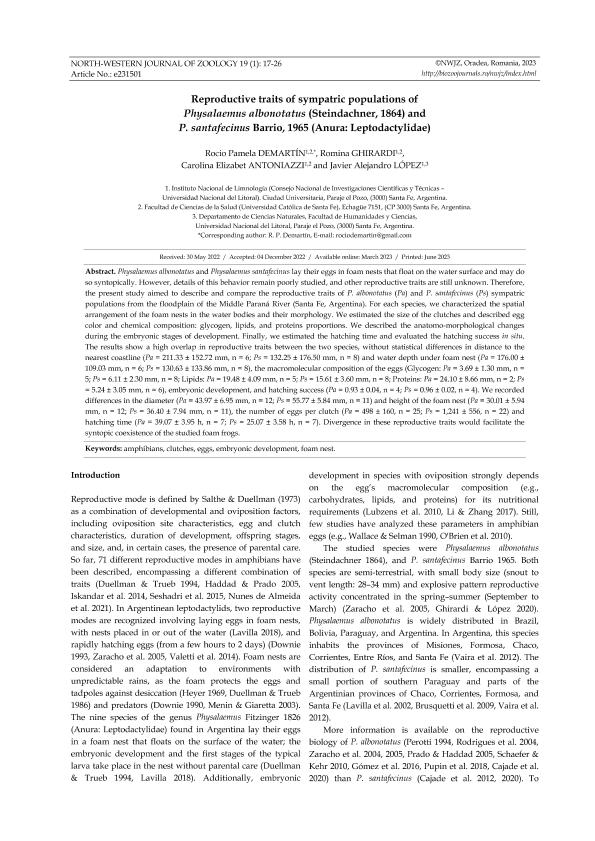Artículo
Reproductive traits of sympatric populations of Physalaemus albonotatus (Steindachner, 1864) and P. santafecinus Barrio, 1965 (Anura: Leptodactylidae)
Fecha de publicación:
05/2023
Editorial:
University of Oradea Publishing House
Revista:
North Western Journal of Zoology
ISSN:
1584-9074
e-ISSN:
1843-5629
Idioma:
Inglés
Tipo de recurso:
Artículo publicado
Clasificación temática:
Resumen
Physalaemus albonotatus and Physalaemus santafecinus lay their eggs in foam nests that float on the water surface and may do so syntopically. However, details of this behavior remain poorly studied, and other reproductive traits are still unknown. Therefore, the present study aimed to describe and compare the reproductive traits of P. albonotatus (Pa) and P. santafecinus (Ps) sympatric populations from the floodplain of the Middle Paraná River (Santa Fe, Argentina). For each species, we characterized the spatial arrangement of the foam nests in the water bodies and their morphology. We estimated the size of the clutches and described egg color and chemical composition: glycogen, lipids, and proteins proportions. We described the anatomo-morphological changes during the embryonic stages of development. Finally, we estimated the hatching time and evaluated the hatching success in situ. The results show a high overlap in reproductive traits between the two species, without statistical differences in distance to the nearest coastline (Pa = 211.33 ± 152.72 mm, n = 6; Ps = 132.25 ± 176.50 mm, n = 8) and water depth under foam nest (Pa = 176.00 ± 109.03 mm, n = 6; Ps = 130.63 ± 133.86 mm, n = 8), the macromolecular composition of the eggs (Glycogen: Pa = 3.69 ± 1.30 mm, n = 5; Ps = 6.11 ± 2.30 mm, n = 8; Lipids: Pa = 19.48 ± 4.09 mm, n = 5; Ps = 15.61 ± 3.60 mm, n = 8; Proteins: Pa = 24.10 ± 8.66 mm, n = 2; Ps = 5.24 ± 3.05 mm, n = 6), embryonic development, and hatching success (Pa = 0.93 ± 0.04, n = 4; Ps = 0.96 ± 0.02, n = 4). We recorded differences in the diameter (Pa = 43.97 ± 6.95 mm, n = 12; Ps = 55.77 ± 5.84 mm, n = 11) and height of the foam nest (Pa = 30.01 ± 5.94 mm, n = 12; Ps = 36.40 ± 7.94 mm, n = 11), the number of eggs per clutch (Pa = 498 ± 160, n = 25; Ps = 1,241 ± 556, n = 22) and hatching time (Pa = 39.07 ± 3.95 h, n = 7; Ps = 25.07 ± 3.58 h, n = 7). Divergence in these reproductive traits would facilitate the syntopic coexistence of the studied foam frogs.
Palabras clave:
Amphibians
,
Clutches
,
Eggs
,
Embryonic development
,
Foam nest
Archivos asociados
Licencia
Identificadores
Colecciones
Articulos(INALI)
Articulos de INST.NAC.DE LIMNOLOGIA (I)
Articulos de INST.NAC.DE LIMNOLOGIA (I)
Citación
Demartin, Rocio Pamela; Ghirardi, Romina; Antoniazzi, Carolina Elisabet; Lopez, Javier Alejandro; Reproductive traits of sympatric populations of Physalaemus albonotatus (Steindachner, 1864) and P. santafecinus Barrio, 1965 (Anura: Leptodactylidae); University of Oradea Publishing House; North Western Journal of Zoology; 19; 1; 5-2023; 17-26
Compartir




